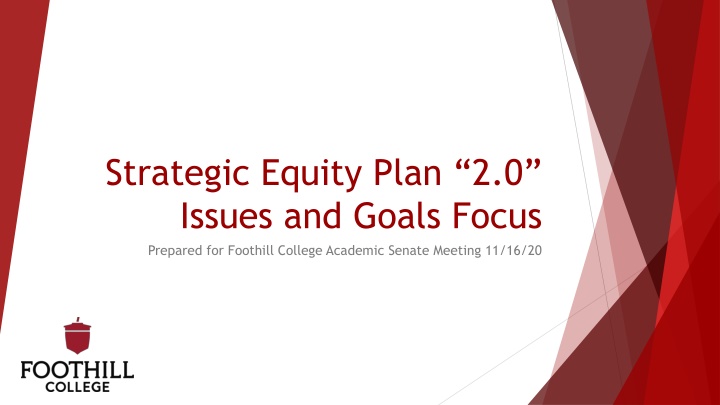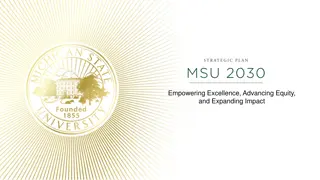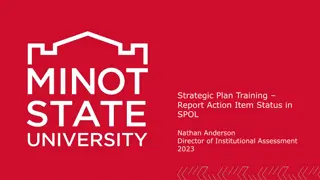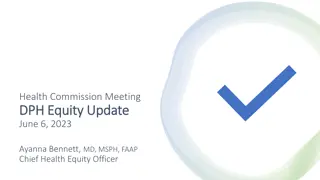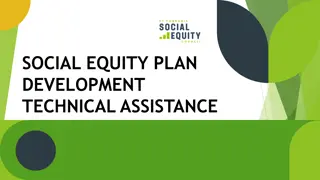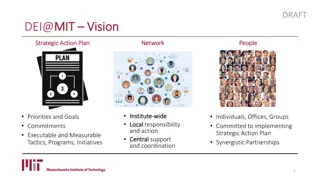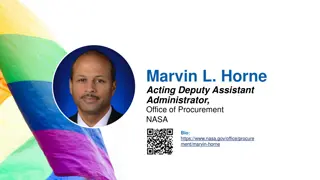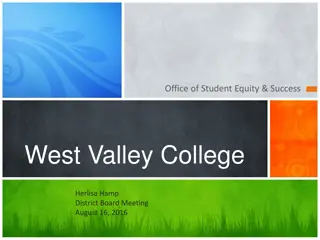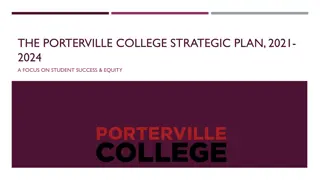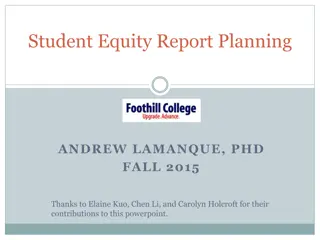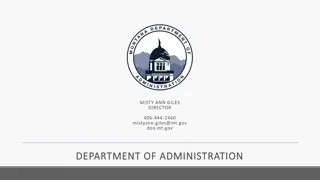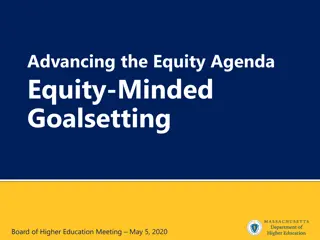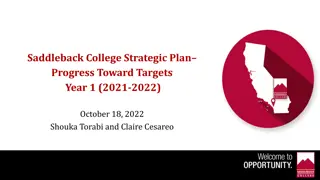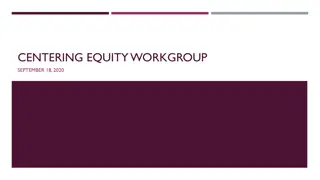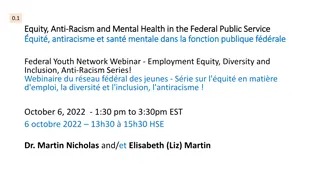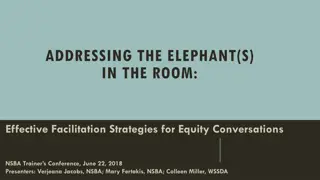Strategic Equity Plan 2.0 Issues and Goals Focus
This document outlines a strategic equity plan prepared for Foothill College Academic Senate meeting. It addresses issues related to student enrollment, onboarding processes, and support strategies, particularly focusing on African American students. Goals include improving the application to registration pipeline, providing personalized support, evaluating online orientation services, and identifying enrollment barriers. The plan aims to empower the campus community to take action aligned with its visionary goals.
Download Presentation

Please find below an Image/Link to download the presentation.
The content on the website is provided AS IS for your information and personal use only. It may not be sold, licensed, or shared on other websites without obtaining consent from the author.If you encounter any issues during the download, it is possible that the publisher has removed the file from their server.
You are allowed to download the files provided on this website for personal or commercial use, subject to the condition that they are used lawfully. All files are the property of their respective owners.
The content on the website is provided AS IS for your information and personal use only. It may not be sold, licensed, or shared on other websites without obtaining consent from the author.
E N D
Presentation Transcript
Strategic Equity Plan 2.0 Issues and Goals Focus Prepared for Foothill College Academic Senate Meeting 11/16/20
Context Issues were informed by Foothill college faculty, staff, administrators, and students State-level equity issues Effort to position each issue in relation to the Guided Pathways Framework Initial interest in attending (clarifying the path) Enrollment (choosing and entering the path) Continued progress (stay on the path) Completion (learning and attaining goal)
Please remember It s a strategic plan, not an action plan Demonstrated issues It s a draft Visionary goals Meant to empower campus to determine their own actions that align with them
Issue: A substantial number of students who have an interest in college, and even apply, do not make it through the intake process to enroll in classes Disproportionately lose African American students in process Goal 1: Improve the application to registration pipeline for students, identifying those areas in the process where the college loses students, paying particular attention on the experiences of African American students, and implementing appropriate interventions. Goal 2: Develop practices that lead students through the onboarding process and include 1-on-1 support when a student encounters an unexpected hurdle. Goal 3: Explore the potential for a districtwide FHDA application
Issue: A substantial number of students who have an interest in college, and even apply, do not make it through the intake process to enroll in classes Disproportionately lose African American students in onboarding process Goal 4: Evaluate, potentially redesign, and implement online orientation with consideration for how students of color experience the service Goal 5: Pilot a case management model within counseling to provide consistent support, exploring models proven to be successful within the African American community Goal 6: Work with the office of online learning, Committee of Online Learning (COOL), and other stakeholders to identify additional barriers in our enrollment and registration processes that may arise when prospective students are not accessing the physical campus
Large numbers of students of color who are arent accessing, are ineligible, or fall out of eligibility for available financial aid programming. Goal 1: Administrative advocacy at the state level to explore elimination of tuition costs for all students across the system Goal 2: Increase student awareness and improve communications about financial assistance programs Goal 3: Students have few or no incidental costs associated with being a student, including but not limited to textbooks, printing, parking costs, as well as a review of financial hold and drop for non-payment policies
More recent focused outreach with a specific intent to increase access and enrollment of Latinx and African American students doesn t connect back to a larger strategy to support and retain these populations Goal 1: Develop a strategic enrollment management plan that outlines touch points from outreach through to enrollment to connect the dots in a way that takes us beyond diversity in access to support and adequate service for these populations. Goal 2: Solidify strategic pipelines from high school to Foothill College for dual enrollment partnerships predominantly serving Latinx, African American, Pacific Islander, Filipinx and low-income students [AB 288/CCAP]. Goal 3: Create a vision for Foothill College to expand community-based partnerships in low-income and historically underrepresented communities. Goal 4: Explore partnership and outreach models for replication or expansion.
ENTRY: Enrollment to completion of 1st college - level course Many students seeking degrees drop out after only one or two terms
Issue: Insufficient infrastructure for basic needs Goal 1: Develop and implement a social services plan that includes the consolidation of these resources, marketing and outreach to appropriate communities, etc. Goal 2: Investigate long- and short-term housing solutions Goal 3: Uncover the specific concerns around transportation, determine what is actionable, what may need to be revisited, and what actions are out of the College s control Goal 4: Address the need for more psychological services, looking into creative solutions to expanding this service to students
Issue: Lack of sense of belonging and space allocation for students of color Goal 1: Campus safety is re-envisioned where police interact with students in a racially and culturally affirming manner, and regularly examine their practices and policies for racial impact Goal 2: Disaggregation of student conduct data by race to explore trends in reporting and sanctions, noting any disproportionate rates of reports to any particular racial group Goal 3: Increase mental health support for students of color, especially around trauma related to police interactions
Issue: Lack of sense of belonging and space allocation for students of color Goal 4: Existing classroom and campus (physical) spaces encourage student engagement and reflect an appreciation of multicultural and multi-ethnic backgrounds. Goal 5: Create a multicultural/LGBTQ, and Dream centers Goal 6: Space allocation processes ensure the design and usage of the space is student-led and student informed. Goal 7: Curriculum and instruction norm multi-cultural and multi-ethnic perspectives
Progress: Entry into program of study through near completion (75% of program requirements) Students persist in spite of life events and academic struggles
Issue: Many disciplines perpetuate the myth that they are objective and race-neutral Goal 1: Pedagogy and curriculum are race conscious A - Faculty are knowledgeable about the epistemology of their disciplines, especially of the contributions of racially diverse scholars and curriculum includes this epistemology B - Faculty are knowledgeable about historical and contemporary racial equity issues in their disciplines and include in their course curricula C- faculty are aware of approaches for using their discipline to prepare students to be social justice leaders Goal 2: Faculty feel supported in their efforts to continually learn about the origins of their disciplines and iteratively refine their teaching
Issue: Many disciplines perpetuate the myth that they are objective and race-neutral Goal 3: The Academic Senate and the Faculty Association support practitioner efforts to achieve goals 1 and 2 by removing structural barriers embedded in areas A-Tenure processes support probationary faculty, tenure review committee members, and mentors in normalizing the practice of being race conscious while being supportive of continuous learning around this issue B-Faculty evaluations are seen as an opportunity to continuously build on the quality of our teaching, replacing the aim of perfectionism built into the process for one that values growth and improvement. C- Academic Senate, in collaboration with the College Curriculum Committee, reviews and reimagines curriculum policies and processes to ensure they are race conscious. Where curriculum policy results in disproportionate impact, the college takes local action to mitigate it and when necessary, works in conjunction with administration to advocate for change at the board and/or state level
Issue: Microaggressions and unconscious bias negatively affect experience and learning for students of color Goal 1: Campus spaces are free from racial microaggressions. Goal 2: Campus culture supports explicit checking of unconscious bias.
Issue: Lack of a college-wide retention plan for students to progress through their academic career at Foothill Goal 1: The college has a coordinated plan with a set of successful, culturally relevant interventions in play that retains students through three important milestones in a term: 1) course registration through to census, 2) from census through the end of the quarter with successful course completion, and 3) successful enrollment in the subsequent term. Specifically, this plan is derived of strategies that not only are proven effective for Foothill s most vulnerable student populations (in this case, African-American and Latinx women), but can be inclusive and encompassing of other populations needs.
Issue: Lack of a college-wide retention plan for students to progress through their academic career at Foothill Goal 2: The college continues to support its retention programs and existing learning communities, strategizing with the programs about how to expand their reach so that more students can benefit from their program s offerings. Goal 3: The college addresses the retention challenges that arise when students, staff and faculty do not have access to the physical campus and cannot meet with students in a traditional face to face environment.
Insufficient culturally responsive, relevant and sustaining pedagogy and other asset-based approaches in teaching and serving our students of color Goal 1: Planning and decision-making is informed by regular review of quantitative and qualitative data Goal 2: Increase the racial diversity of our faculty, staff, and administrators Goal 3: Retain racially diverse employees Goal 4: Faculty are supported in their efforts to iteratively self-evaluate their proficiency with culturally responsive pedagogy Goal 5: Ensure content and pedagogy are inclusive of and created with communities of color in mind
